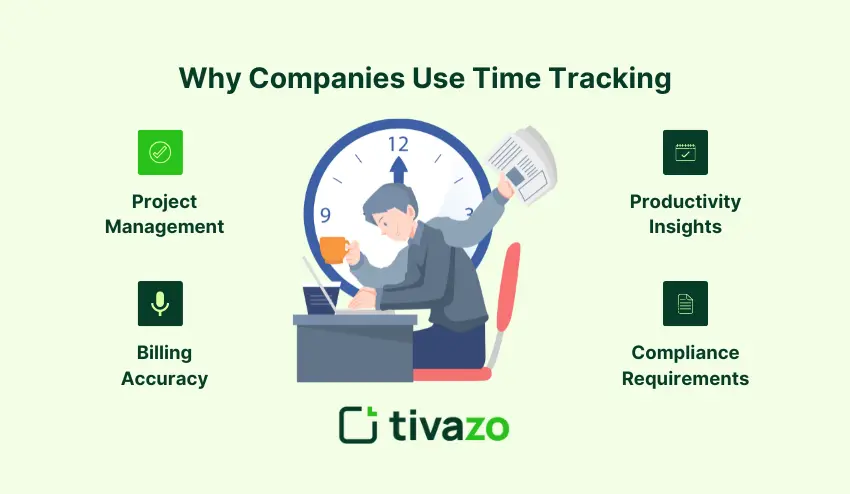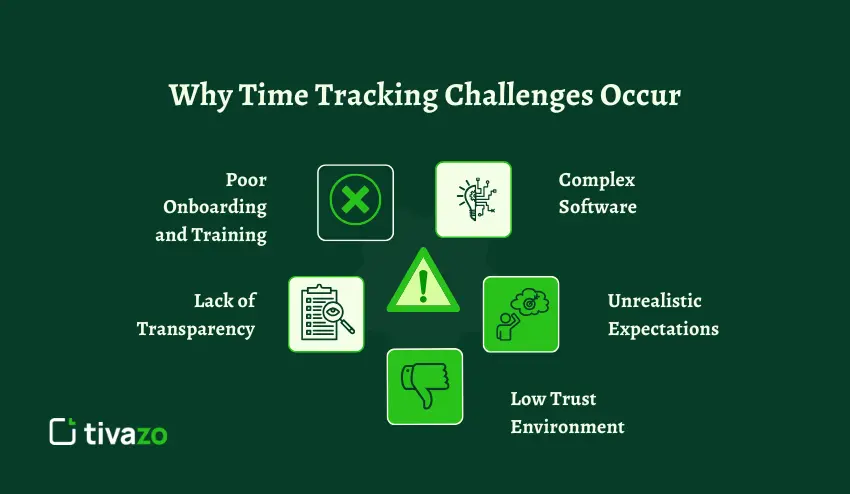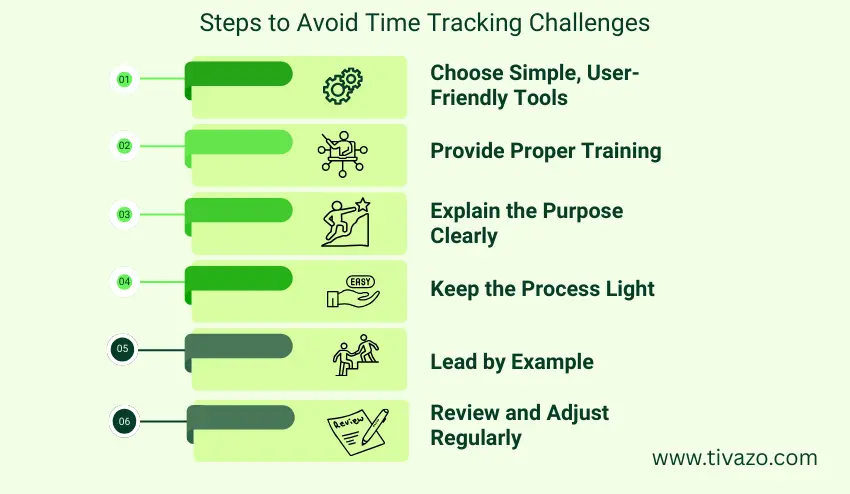Time tracking has become the norm in the contemporary workplace. It is used by companies to measure productivity, resource allocation, and to keep the projects on track. It looks easy on paper. But practically, it has its own time tracking challenges.
If you have ever tried to manage a team’s hours, you know that tracking time accurately is not always easy. Employees may forget to track time, misinterpret the system, or feel stressed that they are being tracked. All these problems accumulate, not only in the productivity but also in the morale of the workplace.
In this guide, we shall examine the reasons why businesses engage in time tracking, the most frequent time tracking problems, their causes, and how to prevent them. This is based on real workplace experience and is written to help managers and employees navigate these challenges with clarity.
Key Highlights:
- Why Companies Use Time Tracking
- Common Time Tracking Challenges in the Workplace
- Why These Time Tracking Challenges Occur
- Impacts of Time Tracking Challenges on the Workplace
- How to Avoid Time Tracking Challenges
Why Companies Use Time Tracking
Before we jump into the question of time tracking challenges, it is worthwhile to know why companies bother to invest in time tracking in the first place. It may sound simple, yet in practice, it is a significant element in the way contemporary businesses are run.

Project Management
Managers in most workplaces require a clear picture of the time spent in various tasks and projects. Time tracking also assists in determining which activity consumes the most number of hours and whether deadlines are achievable. Managers can reallocate tasks, balance workloads, and make sure that projects proceed without any delays when they have correct information about time. This also helps in avoiding project management mistakes.
Billing Accuracy
In businesses that are client-based, such as marketing agencies, consulting firms, or law practices, time tracking is important to bill. It makes sure that invoices are not done on rough calculations but by the actual hours worked. This not only enhances the accuracy of revenue but also instills confidence in the clients since they know what they are paying.
Productivity Insights
Time tracking gives an insight into productivity trends. It exposes bottlenecks, identifies repetitive low-value work, and shows where the employees may be spending excess time. As an example, when a routine report takes three hours to complete instead of one, managers can look into what is causing this and how to make the process more efficient.
Compliance Requirements
Time tracking is not an option in some industries; it is a legal requirement. Organizations in areas such as construction, healthcare, and finance need to keep accurate records to be audited, comply with wage or report to the government. They face fines, court action or loss of contracts without proper time logs.
Time tracking, when applied properly, introduces transparency at the workplace. The management and the employees will be clear on the allocation of work hours, which can enhance planning and eliminate unwarranted stress and avoid time tracking challenges.
But there is another side to the story. When time tracking is not well handled, either because of ineffective tools, unintelligible policies, or employee reluctance, it may lead to frustration and mistrust. It is at this point that time tracking issues start to emerge, and they may not only hamper the work process but also the work culture.
Common Time Tracking Challenges in the Workplace
Any company implementing time tracking system will encounter barriers at one stage or another. These time tracking issues do not concern a specific industry or the size of the company. They may appear in small groups, big organizations, in remote locations or in office locations.
The following are the most common problems of businesses in time tracking.
Inaccurate Time Entries
Inaccurate logging is one of the greatest time tracking challenges. Employees can also miss to record their hours in time, particularly when the system does not remind them. Some may also complete their timesheets at the end of the week and use their memory rather than real time tracking. This will result in guesswork and this reduces the accuracy of data. In other situations, misreporting occurs accidentally when there is confusion on the type of tasks or time codes. The flawed data makes it difficult to make informed decisions by managers on how to allocate resources and timelines of the project.
Resistance from Employees
There can be resistance to time tracking. Some employees may see it as micromanagement particularly when it is initiated without indicating the reason. They might think that they are not trusted, which can decrease their motivation and cause tension. This is one of the time tracking challenges that can easily demoralize the work place unless it is handled.
Overcomplicated Systems
Time tracking tools are not made equal. Others are too complicated to log a simple task or they have technical jargons that leave the user perplexed. In cases where systems are complex, employees will less likely use them properly or at all. This is one of the most avoidable time tracking challenges in my experience. When the process is perceived as an added chore rather than a fast habit, the rate of adoption declines rapidly.
Tracking Too Much Detail
Although it is significant to have the right time tracking, excessive detail may be counterproductive. A good example is when employees are required to document every five minutes of their day, which induces unnecessary stress. It also takes the emphasis off meaningful work. Unnecessary tracking detail is the most irritating time tracking issue on staff because not only does it consume productivity, but it can be invasive.
Lack of Clear Policies
Time tracking will be sloppy without uniform rules. Employees might record breaks or they might not. One may record meetings as billable and others may not. This non-standardization results in varying reports, and this makes analysis hard. Among the various time tracking challenges, ambiguous guidelines can be the cause of most of the mistakes and inefficiencies.
Such challenges do not come out of thin air; they are often the results of underlying system design, communication, and workplace culture problems. In the following section, we are going to take a look at why these time tracking issues occur and what predisposes them.
Why These Time Tracking Challenges Occur
In my experience, the majority of time tracking challenges are not the result of the concept of tracking time, but the way the system is introduced, explained, and managed. Without a sense of the purpose or the process being too complex, problems are bound to arise.

Poor Onboarding and Training
Unless the employees are demonstrated how precisely to use the tool and why it is important, errors will occur. It cannot be a fast announcement via email. Without practical instructions, employees can operate the system wrong or even ignore it.
Lack of Transparency
When the management does not clarify how time tracking can benefit the employees- not only the company- it becomes a feeling of surveillance. This perception may easily lead to resistance, and one of the most widespread time tracking challenges becomes more difficult to resolve.
Complex Software
A time tracking tool can be the most effective, but it will be useless when it is confusing. Long menus, confusing categories, excessive steps, and complexity make it less likely to be used regularly. When it is more work to log time than it is to do the job, employees will become creative in evading the process.
Unrealistic Expectations
It is not realistic to expect employees to record every minute of the day correctly. Individuals alternate tasks, are interrupted, and make brief pauses. Making the rules too rigid makes time tracking a stressful task and creates time tracking challenges for the company and the employees.
Low Trust Environment
When trust is already weak at work, the introduction of time tracking without proper communication seems like controlling. Rather than encouraging efficiency, it may destroy relationships between employees and the management.
The first step in preventing such time tracking challenges is to understand why they happen. Next, we will observe what will occur in case these challenges are not addressed.
Impacts of Time Tracking Challenges on the Workplace
Failure to deal with time tracking challenges will result in rapid impact on the organization.
- Lower project planning precision – Project schedules are impaired without credible time data.
- Reduced morale of workers- When the workers feel that the tracking is not fair, they will not take part in the process.
- Unnecessary wastage of resources- Time wasted in correcting mistakes or in searching for missing entries could be utilized in real work.
- Billing issues- In case of client-based business, incorrect time records may result in billing problems.
- Trust problems- When tracking systems are not well managed, they may cause tension between teams and management.
These effects explain why time tracking issues should be one of the concerns of any company that cares about productivity and collaboration.
How to Avoid Time Tracking Challenges
The silver lining is that the majority of time tracking challenges can be avoided–or at least significantly minimized–through the correct strategy. In my experience, success is all about getting the right tools and the right mindset.

Step 1: Choose Simple, User-Friendly Tools
Choose a time tracking software that is user-friendly and quick. The system must allow the employees to clock their hours with only a couple of clicks without having to go through extensive menus. Tracking can also be made more consistent with a system that functions on desktop and mobile as well.
Step 2: Provide Proper Training
Do not expect that people will figure it out. Provide brief instructions, demonstrations, or tutorial videos to allow employees to view the precise process of using the system. Proper training will get rid of guesswork and help avoid most of the typical time tracking challenges before they occur.
Step 3: Explain the Purpose Clearly
Explain the advantages of time tracking to the employees and not only to the company. As an example, it can also point out the instances where workloads are excessive, which can assist managers in redistributing tasks. Once individuals know what they will gain out of it, they are much more willing to participate.
Step 4: Keep the Process Light
Ask only the details that you really require. Employees will resist when it takes more time to track than to do the task. The idea is to ensure that logging time is a fast habit, not a chore.
Step 5: Lead by Example
Managers are expected to monitor their time under the same system. Having leadership involved will convey the message that time tracking is all about fairness and productivity, not control.
Step 6: Review and Adjust Regularly
Regularly check the data of the system and employee feedback. When the tool is slowing people down or some rules are not working, adjust. One of the simplest ways to prevent constant time tracking challenges is to remain flexible.
With these steps combined, companies will be able to transform time tracking, which is a tedious necessity, into a beneficial practice. The easier, more open, and fair the process is, the more likely it is to be embraced by employees.
Conclusion: Turning Challenges into Opportunities
The presence of time tracking challenges is not an indication that the process is broken and cannot be fixed. They are just indicators that something is wrong and that there is a need to change something.
Time tracking can be used to benefit both the company and the employee when done with the appropriate tools, clear communication and reasonable expectations. The trick is to make it a management-staff partnership, and not a control system.
By tackling these issues early enough, you will not only enhance productivity but also instill a work environment that people will feel valued and trusted.


